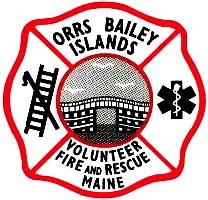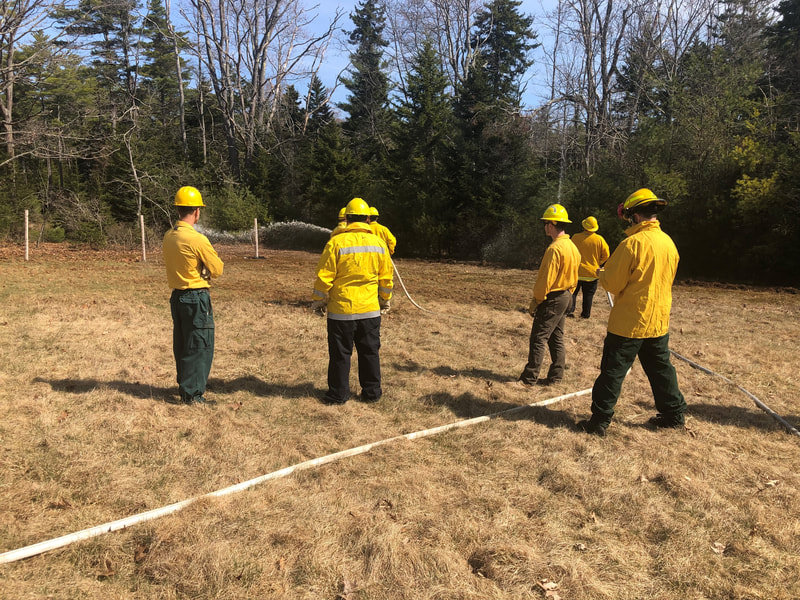|
Seven responders from the three Harpswell Fire Departments (Jack Stokinger from Harpswell Neck; Mason Smith, Mike Hartman, and Rosie Buonauito from Orr’s & Bailey Island; and Meriel Longley, Mario Baldi, and Steve Rowe from Cundy’s Harbor) recently participated, along with 43 other members of fire departments throughout the State of Maine, in a wildland fire training course offered by the Maine Forest Service. The training was composed of 3 online courses, each followed by exams. Those who passed could apply for certificates, which would make them eligible for in-the-field practical training. The practical training was held on April 15, 2023, off Breakwater Farm Road in Cape Elizabeth. Last summer, Harpswell had several woodland fires, including a 3-day burn on Great Island. These may have served as part of the impetus for the large attendance from Harpswell this year. Woodland firefighting requires a different skill set, different clothing, and different gear than is required to fight house fires. Of note is the fact that these courses are open to non-firefighter members of the public. Once trained, certified individuals may volunteer to work alongside regular firefighters putting out woods and fields fires. The online portion of the training covers a wealth of practical and safety information. Some examples are in learning the use of the equipment required as well as the descriptive terminology surrounding fires, such as head, tail, flanks, islands (areas not burning) and fingers (offshoots of fire heading in different directions). Required clothing consisted of shirts and pants preferably made of Nomex, a non-flammable material, together with helmets and leather boots. This differs from the typical turn out gear worn by those who fight house fires. Turn out gear is heavy and hot, but offers great protection. The lighter clothing worn by wild lands fire fighters allows for agile movement and for hiking long distances while carrying heavy packs of equipment. Responders are trained to stay no closer than 10 feet apart to prevent falling into each other while carrying tools and equipment.
The online course also covers the effects of different types of weather, including wind and humidity on fire and smoke. Participants learn never to go uphill from the fire so as not to be trapped in the flames that travel upward. They learn about controlled burns of areas where a fire is heading so that by the time it gets there, there is no fuel (grass and foliage) for it to burn. Since helicopters are often used, participants learn safety protocols around them in terms of avoiding the tail and also any part of the helicopter on the downhill part of a slope since the blades can be too low there. At the field exercise on April 15, the Forest Service did not actually set a fire as weather conditions made it too dangerous, and fire risk had been high all week. They did bring in a large, Viet Nam era UH-1 helicopter (a “Huey”) for practice. A Huey is designed to carry a lot of weight including water and rescued people. A collapsible bucket holding 240 gal of water can be dropped into a pond to fill and is then transported as it hangs below the helicopter and is released over the fire. The water can also be released into portable tanks which are brought to the fire by trucks. Course participants had the opportunity to witness and participate in helicopter operations. They also practiced hiking to the site with packs carrying, portable pumps, hoses, shovels, axes, spades and other equipment. They practiced the use of portable pumps. Very important was learning to work in teams. Responders were divided into teams of 20 and would form a line in order to dig fire lines to contain the fire. The first group would use axes and picks to break through sod and roots. Moving along the line horizontally, others would clear the area with rakes and hoes. Others would move in with shovels to dig a trench. Another important team training was fire observation and communication. Team leaders and fire observers, as well as sometimes those in helicopters and planes, observe the movement of the fire while responders are immersed in their work. Location and movement of the fire is constantly broadcast and shouted down the line in order to prevent anyone from becoming trapped. Information about wind and humidity changes and fires getting into different types of fuels (wood and plant life) is communicated. The participants are trained to be constantly identifying possible escape routes and safe areas such as graveled or rocky areas. The event of using an escape route in order to shelter in a safe area is one to be avoided, and is used only as a last ditch effort to save one’s own life. It usually only happens when a fire changes or increases abruptly and tremendously. The safe area is typically a space devoid of burnable plant life and could be surrounded by fire. In that case, participants are trained to get into a portable shelter which they carry with them. It consists of a foil blanket which forms a three-sided cocoon. The responder crawls into it and lays on the ground close to others in the same situation so that they can communicate with each other. This is an event that triggers a state investigation and reporting to find out why it happened and how to prevent it in the future. By all reports, the entire course was interesting and packed with information, and the field experience was challenging and exhilarating. Hats off to to the participants, some of whom also participated in the ice rescue training in February. Harpswell can feel safe in the hands of our competent and diversified responders who are constantly pursuing up to the minute knowledge and skills.
0 Comments
Leave a Reply. |
OBIFD NewsOur latest press releases can be found here. Check back often for updates. Archives
March 2024
Categories |







 RSS Feed
RSS Feed